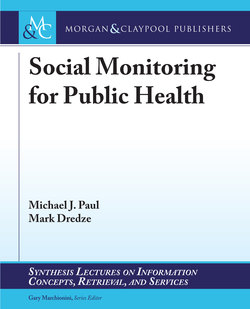Читать книгу Social Monitoring for Public Health - Michael J. Paul - Страница 9
На сайте Литреса книга снята с продажи.
ОглавлениеPreface
In October of 2010, Michael was a new computer science Ph.D. student at Johns Hopkins, Mark was his research adviser, and we were both attending the conference on Empirical Methods in Natural Language Processing (EMNLP). Sitting in a Boston restaurant one night of the conference, we started talking about this new website called “Twitter” and what interesting research we could do with millions of tweets. One of us wondered if anyone talked about health on the new social media platform. At the end of the conference, Mark sent an email to Michael:
I did a quick search out of curiosity. I looked at half of 1% of our twitter collection…to pull out all tweets that have the word “sick”…You can see that there are lots of tweets where the author [writes] sick, but of course it’s not such a simple problem.
That email led to Michael’s class project, which led to our first paper together at the International Conference on Weblogs and Social Media (ICWSM) [Paul and Dredze, 2011]. That paper contained many of the ideas we’d follow in subsequent years: structured topic models, topic analyses for social media, influenza surveillance, drug and tobacco use, health behaviors, mental health, and geo-locating tweets. Since then, it’s been a whirlwind of research, and we’ve each developed a deeper interest in public health.
In some sense, the field of social monitoring for public health has followed a similar path. Initial work on using Google and Twitter for influenza surveillance progressed to surveillance for other infectious diseases, and quickly branched out to a wide range of public health topics. Before we knew it, an entire field of research had grown around us.
As we read newly published papers in this area, we were amazed by the creativity and breadth of what was being achieved. We collected our observations and began to notice common themes and structures across research areas, structures that could organize the field and allow it to move forward. It made sense to write down what we observed, and before we realized it, we had a book.
This book is a reflection of the past decade of research, a summary of how we reached this point and what has been done so far in this fast-paced field. We can’t predict the future, but by understanding what we have achieved so far, we hope to provide researchers with a foundation on which to build the future of this field.
Michael J. Paul and Mark Dredze
August 2017
